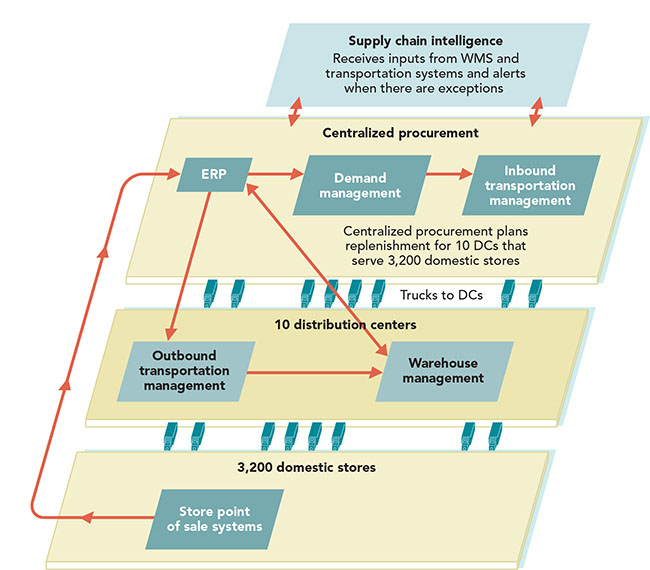Papa John’s: WMS and voice technology optimize operations
Pizza maker Papa John’s relies on a suite of supply chain software applications and voice recognition technology to deliver the freshest dough and ingredients to its stores.
Latest Material Handling News
Registration open for Pack Expo International 2024 Walmart chooses Swisslog AS/RS and software for third milk processing facility NetLogistik partners with Vuzix subsidiary Moviynt to offer mobility solutions for warehouses Lucas Watson appointed CSO for Körber’s Parcel Logistics business in North America Hyster recognizes Dealers of Distinction for 2023 More NewsPapa John’s
Louisville, Ky.
Network size: 10 strategically located distribution centers
Stores serviced: 3,200 in North America; 4,400 worldwide
Products: Pizza dough and ingredients
SKUs: Each DC manages between 130 and 180 SKUs
Total throughput: On average, Papa John’s domestic supply chain ships more than 1,000,000 pieces per week.
With a focus on freshness, Papa John’s replenishes its 3,200 North American stores two times a week from a network of 10 strategically located distribution centers. While materials handling and warehousing processes are conventional and fairly simple, the pizza company has implemented voice recognition technology and a sophisticated array of supply chain software applications to optimize inventory, meet regulatory requirements and get visibility in the event of a recall. Here’s a look at how they all come together to deliver the freshest ingredients to the stores.
Demand planning/store replenishment: Distribution centers were once responsible for ordering replenishment inventory for their facilities. Today, inventory management has been centralized into an inventory management group. The system makes replenishment suggestions based on inventory levels, orders already in the system, lead times and anticipated demand that may be influenced by seasonal events and promotions. The planning system passes purchase orders to the inbound transportation management system to create deliveries. For instance, some DCs may not be able to accept a full truckload of perishable product; as a result, the system may order a truckload of product with multiple stops for delivery or pick up product from multiple vendors to create a delivery to one DC.
Inbound transportation management/supply chain intelligence: Once the purchase orders are complete, the inbound transportation management system creates a delivery plan, tenders the loads and receives acceptance messages from the carriers. A supply chain intelligence application monitors deliveries and notifies Papa John’s when exceptions to the plan occur, such as a late delivery. That allows the team to proactively address any potential issues. In the near future, the system will also automate appointment scheduling, which is now handled manually.
Receiving and putaway: When a truck arrives at the dock, the driver is checked in and the trailer is inspected to make sure the load is still sealed. Once the trailer is opened, a license plate bar code label is applied to the first pallet and scanned to capture SKU and lot information and begin the receiving process in the warehouse management system (WMS).
The WMS is also tracking the product based on its shelf life—for example, product that does not have a sufficient number of shelf days will be reviewed before being accepted; similarly, the WMS and voice system won’t allow product with insufficient shelf days to be shipped to a store.
Once receiving is complete, lift truck operators, rather than the WMS, determine the best storage location for the product and scans the location bar code label to confirm the putaway. DCs include freezer, refrigerated and ambient temperature zones. Inventory does not remain in a DC for long: Some inventory is turned on a daily basis.
Replenishment planning: Replenishment is a three-day process. For a store receiving a delivery on Wednesday, the process will begin Monday night when the store closes out the register. The point of sale system (POS) will prompt the manager to create a food order. The store has until 3 p.m. the next day to make changes to the order. At 3 p.m., orders for each DC are entered into the outbound transportation management system (TMS). The TMS dynamically creates delivery schedules based on a number of parameters, such as when stores can receive deliveries, how much product will fit on the truck and when the truck can be dispatched. Once a dispatcher reviews and approves the routes, they are passed to the WMS, which creates waves.
Order selection and shipping: When the WMS creates a wave of orders, it allocates inventory by truck and creates picking tasks on a last-out/first-in basis. Typically, dough is picked first, followed by frozen products, refrigerated items with ambient temperature product going on last. As a rule, an order will represent items going on one truck. When order selectors receive their tasks, they log into their voice unit. The system then directs an order selector to the first location for a pick. The order selector is prompted to provide verbal responses to confirm each step of the process, including the capture of lot information. Once the truck is loaded, the driver physically counts the truck to verify that all of the items for that delivery have been loaded into the trailer.
System suppliers
Supply chain execution and management software: Manhattan Associates
Voice recognition technology: Honeywell—Vocollect Voice Solutions


Article Topics
Latest in Materials Handling
Registration open for Pack Expo International 2024 Walmart chooses Swisslog AS/RS and software for third milk processing facility NetLogistik partners with Vuzix subsidiary Moviynt to offer mobility solutions for warehouses Materials Handling Robotics: The new world of heterogeneous robotic integration BSLBATT is looking for new distributors and resellers worldwide Lucas Watson appointed CSO for Körber’s Parcel Logistics business in North America Hyster recognizes Dealers of Distinction for 2023 More Materials HandlingAbout the Author
Subscribe to Materials Handling Magazine

Find out what the world's most innovative companies are doing to improve productivity in their plants and distribution centers.
Start your FREE subscription today.
April 2024 Modern Materials Handling

Latest Resources










